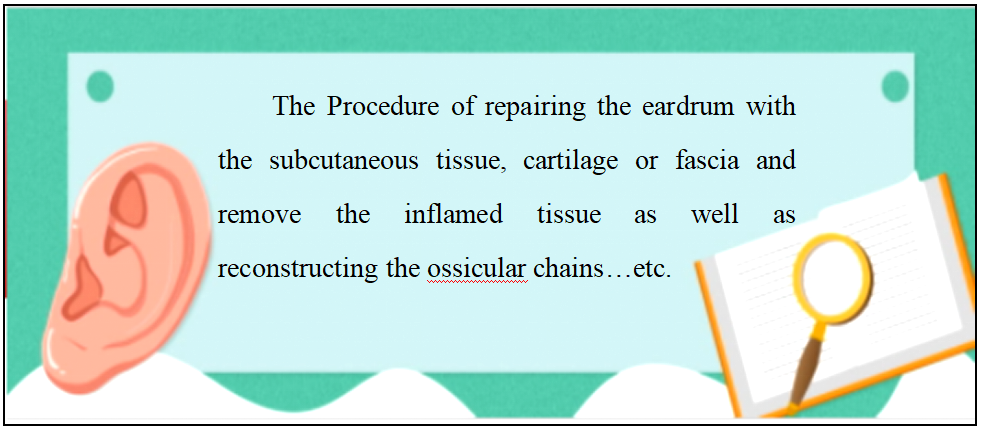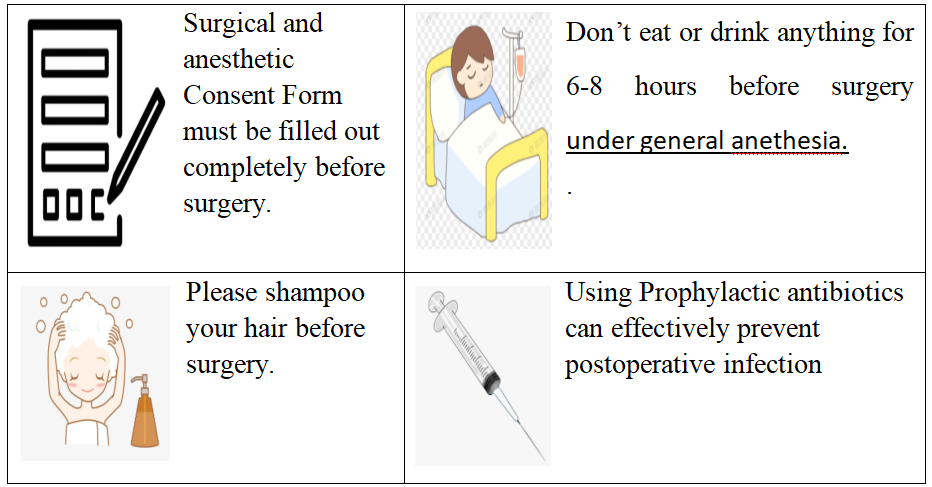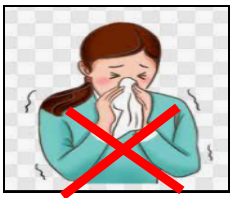【Learning points】
- Ear anatomy. Tympanoplasty was to remove inflammation tissue, to reconstruct ossicle chain and used temporal fascia or perichondrium to repair tympanic membrane.
- Rinse your mouth with water after eating and keep your mouth fresh and clean.
- 2 weeks after surgery, Do not lift heavy stuff. You should avoid heavy physical labor and lifting.
I.Surgery summary/ anatomy
Our ears, allow us to hear and keep balance, have three parts:
- The outer ear, which includes the auricle and the ear canal. The ear cannal goes inside to the eardrum.The medical term for eardrum is tympanic membrane.
- The middle ear, which is made of three small bones called the ossicles, facial nerve and E-tube, etc.
- The inner ear or the cochlea.
A common disease such as chronic suppurative otitis media, it can lead to perforation of eardrum, conductive hearing loss,or cholesteatoma , then it may require surgery to repair the damage of the eardrum or ossicles, to reconstruct the hearing and prevent further infection.

II. Preoperative Instruction

III.Postoperative Instruction

- At the ward, your nurse will inform you the time when to start eating. You can eat soft diet, but avoid drinking from a straw.
- Rinse your mouth with water after eating and keep your mouth fresh and clean.
- Lying on opposite side of the wound. Compression over the wound should be avoided.
- The surgeon will place the cotton ball in the ear canal or wound will be wrapped with elastic bandage which will be remove after 2 to 3 days. Your nurse will place the cotton balls inside the ear canal to absorb excess discharge,change the cotton balls daily if it get wet or dirty.Keep the wound dry; stitches are usually removed in the outpatients departments 1-3 weeks after surgery.
- You may hear a strange noise in your ear such as gurgling. This is part of the normal healing process. Do not insert a cotton swab into the ear canal or take out gelfoam from it. Your surgeon will remove the gelfoam 1-3 weeks after surgery.
- It is a normal symptom to have hemoptysis, tingling or itching sensation inside the ear canal.
- You may feel dizzy when you get up from bed after surgery. Rest as much as possible after the surgery. Get up from a lying position slowly, stay seated for a few moments before standing, and asking for assistance.
- If you notice any symptoms of redness, discharge, swelling, or ear pain, you should visited the doctor as soon as possible.
- Be sure to talk to your doctor before airplane travel and mountain climbing.
IV.The prevention of complications
- Keep the wound clean and dry.When showering or washing your hair, place a piece of cotton coated with antibiotic ointment into the ear. Apply the ointment over the suture. Removing and reapplying the ointment after showering.
- Avoid visiting crowded or public places to prevent yourself from getting the cold or flu.
- Avoiding irritating foods such as cigarette, wine, coffee, strong tea and spicy food…etc; do not chew betel nut, gum or other hard foods to prevent the wound from bleeding.
- 2 weeks after surgery, Do not lift heavy stuff. You should avoid heavy physical labor and lifting.
- Do not completely covering your mouth and nose. If you have to sneeze, open your mouth and let the air pressure go out of your mouth.
- It’s a good habit to have a bowel movement regular. Avoid holding your breath and straining to defecate.

V.Conclusion
Otitis media can be divided into acute and chronic, and the condition can be mild or severe. If not treated early, it may permanently affect hearing. To cure otitis media, in addition to medication, early surgery to deal with water accumulation, eardrum repair, or "mastoidectomy" to deal with cholesteatoma are the keys to saving hearing.
VI.References
- Li, B., Zhou, L., Wang, M., Wang, Y., & Zou, J. (2021). Endoscopic versus microscopic surgery for treatment of middle ear cholesteatoma: A systematic review and meta-analysis. American Journal of Otolaryngology,42(2), 102451. https://doi.org/10.1016/j.amjoto.2020.102451.
- Kim, D. J., Lee, H. M., Choi, S. W., Oh, S. J., Kong, S. K., & Lee, I. W. (2021). Comparative study of endoscopic and microscopic tympanoplasty performed by a single experienced surgeon. American journal of otolaryngology, 42(1), 102788. https://doi.org/10.1016/j.amjoto.2020.102788
- Chuan-Jen Hsu(2004). Management of Chronic Otitis Media. The Journal of Taiwan Otolaryngology-Head and Neck Surgery, 39(1), 22-26. https://doi.org/10.6286/2004.39.s_1.22
簡易測驗
Let’s take an examination to confirm you fully know the content of health education.
評語
統計結果不開放
請登入後才可以評分
未登入或權限不足!
- 位置
-
- 資料夾名稱
- English
- 上傳者
- 張曉娟
- 單位
- 中榮護理衛教
- 英文名稱
- MIDDLE EAR SURGERY CARE EDUCATION
- 分類
- 手術
- 科別
- 英語
- 癌症照護
- 否
- 建立
- 2024-01-27 23:03:25
- 制訂日期
- 2015-10-07
- 最近修訂
- 2024-03-19 11:52:00